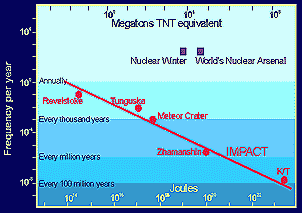| Book Review Archive 17.03.2002 [25] |
|
||||
|
by Bill McGuire
Bill McGuire, a Professor of Geohazards at UCL, successfully debunks the "as it is so shall it ever be" apathy that the masses are so enamored of. People seem remarkably able to shrug off any hint of reality, in the face of almost any evidence to the contrary. A tabloid consciousness requires a straightforward attack to get an unpopular message through, and this McGuire provides in spades. In Western Europe and much of America all seems well with the planet itself, even if our own behavior leaves much to be desire. But ask other peoples how they feel and a different picture emerges.
Hardcover jacket, Oxford University Press, 2002
The relatively placid weather, and quiescent geology, experienced by much of the West is, on a global scale, abnormal – and even in the West, merely a period of calm between storms.
McGuire covers threats that emanate from our planets weather systems, from our planets geomorphology, from space and from human activity. There is little that we haven’t seen before, but in dribs and drabs. Given the unknown possibility of synergy between different threats, putting them all together paints a fairly dire picture – and one that we are usually bizarrely able to ignore.
Quakes, Volcanoes and Tsunamis
There are, apparently, an average of 1400 earthquakes every year. The 1995 Kobe earthquake took 6,000 lives and cost $200,000,000. In 1999 a quake near Istanbul took 17,000 lives. These areas are near the zones where tectonic plates meet. Of course, not all quakes take place at plate margins. The quake that felled Colchester, in the English county of Essex early last century was quite unexpected [though on a faultline it was nowhere near a plate boundry]. And in 2001, in the Indian state of Gujaret, an earthquake killed nearly 100,000.
It is McGuire’s view that it is the human habit of surrounding ourselves with artificial caves that causes much of the death toll. Buildings fall down – there is often nowhere to run.
Shaking seemingly solid earth can liquefy it. This particularly surreal cause of mass destruction is a frequent result of both quakes and volcanic activity. Sometimes people are just sucked into what was moments earlier solid ground. Often the ground begins to slide under the influence of gravity, and picking up momentum, destroys all in its path. In Armero, Colombia, 23,000 died as a result of ice melt and ground shake during a relatively minor volcanic eruption miles away from the town.
Volcanoes can also send rivers of molten lava streaming miles out from its immediate area, or chuck massive rocks high into the atmosphere, only to rain down on the heads of those nearby. They can suck up air and choke you on poisonous fumes, or on ash and dust.
This ash is one of the most destructive things that can be unleashed by volcanoes. A large eruption can fountain out enough ash to effect changes to the weather on a global scale. You may have seen the famous paintings of people skating on the River Thames in London in the late 17th century AD. The mini ice–age experienced throughout Europe at this time is believed to have been exacerbated by the blocking of sunlight across the globe after a volcanic eruption in Asia. This is a Volcanic Winter. During such an event, which can affect global weather systems for years, harvests are affected worldwide, leading to famine everywhere.
One rather frightening scenario that McGuire describes involves "super–eruptions". They seem to occur perhaps once every fifty millennia, the last one having happened about 74,000 years ago. So, we appear to be a little overdue for the next one – and human extinction is genuinely a possible outcome.
If this seems overstated, McGuire’s description of the last such super–eruption [the Toba event] should quickly disillusion you. The human population post–Toba was reduced through starvation to probably only a few thousand individuals. There is every possibility of a species not coming through such a population bottleneck. Genetic evidence would appear to back up this view, showing that we are all far more closely related to each other than would be the case without a bottleneck at about 74,000 years ago. Today, disease and civil disorder would act, alongside the starvation, to certainly wipe out our "civilization", at the very least. And we, in the West at least, are peculiarly ill–adapted to any real hardship, having trashed all the knowledge that had been passed from generation to generation before the Industrial Revolution destroyed the extended family and reconfigured the fabric of our societies.
In 1998, Papua New Guinea was hit by a 17 meter high Tsunami. It left many villages wiped out, and killed 3,000 people. This giant wave was caused by an offshore quake, though Tsunami’s can also be caused by volcanic activity.
This scenario may be played out in the Atlantic sooner than you may like to contemplate. On La Palma, in the Canary islands, a 1949 landslip caused by volcanic activity caused the western part of the island to drop 4 meters. It seems to be barely stable, and poised for another collapse. Geologists cannot say with any certainty whether this may occur tomorrow, or in 1000 years time, and further volcanic activity may be required to trigger it – but it is not a question of if, only of when...
McGuire’s description of the likely tsunami that will result is pretty scary for anyone that lives on the Atlantic coasts of Spain, France, the UK & Ireland, North Africa and the Eastern seaboard of North America. Seven–meter high waves would hit the UK, but, with the broad width of the deep Atlantic to gain height across, the tsunami would be sky–scraper high by the time it reached New York. "Under such a terrible onslaught all life and all but the most sturdily built structures will be obliterated." With only 9 hours notice, "the death toll is certain to run into millions if not tens of millions."
Short of such mega–disasters, though, McGuire does sound an optimistic note:
McGuire also notes that human action in the environment may be affecting these natural forces. It is, apparently, expected by some that volcanic and other geologic disasters could be exacerbated by, for example, sea level rise, and increased rainfall. Read the book to learn how!
Floods, Rain & Wind
However, it is now expected that the effects will worsen for another reason – human influence on the environment.
Human EcoThreat
Human activity on the planet has only recently begun to have the monolithic global consequences that we now fear. The public has heard of Global Warming, of course. The media appears hell–bent upon an extremely conservative placatory position on this subject.
Of course, both ice ages and greenhouse periods occur naturally. This is a fact that is often oversold by the anti–Green lobby, whose argument goes that we cannot interpret the current global weather pattern changes as being man–made in the light of these natural fluctuations. However, as we get a grip on the history of these natural fluctuations, it becomes increasingly clear that the current changes we are unarguably experiencing do not seem to fit the patterns of past change. This, too, is not proof that the changes are unnatural, but they surely cannot be ignored.
Ironically, given that the changes we observe are generally agreed to essentially be causing an overall warming of the atmosphere [regardless of local variation], according to the past evidence we should be entering a period of Ice Age about [geologically speaking] now.
Often, the lobby that do not accept that global warming is real, attack scientists and activists who warn of the threat of global warming by focusing on the fact that we do not, in many areas, witness warming, but sometimes even the reverse.
This is not, however, because there is no global warming, but because the phrase is misleading. It is safer, perhaps, to warn instead of Climate Change. The average global temperature appears to be rising, whatever local variations may convince the casual observer that it is not. The West, especially, has a perceptual problem here. It is easy to dismiss an overall global temperature rise as being scare–mongering, if you live in regions that, while experiencing obvious changes in weather patterns, appear if anything to be the same as ever, or even to be cooler.
It has been noticed, of course, that hurricane activity is increasing in the south–east US, and that European summers appear to be less intense and shorter. The winters are, perhaps, more complex. In the UK winters appear to also be shorter and less intense, while in the Palestine snow fell in Jerusalem this year.
These contradictory signals do not mean that there is no real problem with the weather, although the west has been complacently judging the weather to be going through entirely usual unpredictable fluctuations. Of course, all "averages" are fictional in a sense, with many of the incidents that in aggregate create them not actually falling all that close to them – the random element cannot be dismissed. This has made it easy for a "Sceptical Environmentalist" such as Bjorn Lomberg to loudly berate the green lobby for scare–mongering.
Happily, McGuire, also an academic – which always helps – gives Lomberg [a "self–deluded Danish statistician"] short shrift. Of Lomberg’s work, he says this:
After giving his response, backed up by copious evidence, McGuire’s counterblast includes these sentences:
For the UK and Western Europe, ironically, this overall average global warming will likely appear to be the reverse. This is why Climate Change is perhaps a safer term to use in trying to institute change here.
The view of many scientists now, is that the Gulf Stream, that brings hot Caribbean waters into the North Atlantic, may well be slowed and indeed perhaps stopped by the effect of weather fluctuations on ocean currents. The North Atlantic Oscillation involves the interaction of currents in the North Atlantic with the Gulf Stream. If climate change causes this oscillation to block the Gulf Stream, then it is expected that the UK and Scandinavia will freeze.
This has occurred before, hence the implication of cyclic change in the term North Atlantic Oscillation. Like el Nino, the NAO is, however, apparently moving out of true with expectations based upon past experience. This aberrant action, if it is correct to interpret it as such, may be caused by the overall global warming, despite the seemingly contradictory experience of more storms and less heated summers experienced in northern Europe and north–eastern North America.
Since some of the main engines of Western opinion exist in these territories, it is expected that changing our interaction with the weather systems should be rather difficult, even disregarding the obvious resistance we should expect from industry and the trans–national corporations.
Space Junk
McGuire describes the early millennia of our solar systems evolution in such a way that we can feel great relief at being around now, and not then. The planets grew out of the accretion of matter – ie: millions of bits of space junk crashing together over millennia until larger bodies existed, which then proceeded to mop up any remaining debris, and each other, through collision. The surviving large accretions reached approximately stable orbits and are now called planets, upon one of which we currently reside.
Of course not all the junk has been hoovered up...
Comets, asteroids and meteors have been tabloid headliners and Hollywood film fodder for years. But few people have really absorbed the full impact [no pun...] of this threat. A big explosion, and a band of intrepid heroes averting the worst of it, saving the neighbors dog? Dream on!
Yet, even after the tele–broadcasts of the Levy–Shoemaker comet colliding with Jupiter in 1994, people still just don’t get it. Just one fragment, 4 kilometers across, hit with the impact of 8,000,000,000 Hiroshima’s. You could have dropped the Earth into the center of just one of the impact splash zones with room to spare. The publicity did evince a response at government level, and there are now several programs aimed at mapping all near–Earth asteroids and comets.
Once every hundred years we bump into a chunk 40–50 meters across. This will not burn up on entry, and would easily wipe out a city if it hit one. If it hit the ocean, the Tsunami scenarios above would possibly cause even more destruction regardless of distance from the impact zone. Of the millions of bits of junk near Earth, it is estimated that 100,000 are over 100 meters in diameter, and 20,000 half a kilometer across. This would destroy whole countries.
However, the juicy hits are from 1 kilometer–plus junk. This is "barely equivalent to ten soccer pitches laid end to end", but would cause global devastation, and a Cosmic Winter. There are probably about 1,000 rocks this big floating around out there. Only 320 of these are accounted for.
These, though, are just the rocks. We also have to face the threat of comets. These are generally less dense than asteroids, but more than make up for that in speed and inertia. They travel at what on Earth would be super–sonic speeds, which is about 3 times faster than the average asteroid. They are, therefore, a good deal more destructive. We would have relatively little warning if one was coming our way, and even less ability to do anything about. Space nukes and SDI / Star Wars defense systems would help not at all.
Estimates of our likelihood of meeting one of these babies vary, but we can be sure that an ELE [extinction level event] would be fairly likely.
McGuire is not reticent about describing the results of such an event on the human population. I won’t spoil it for you by repeating his descriptions here, but instead urge you to read the book. Don’t lose sleep over it, but "Some thirteen asteroids – mostly quite small – could feasibly collide with the Earth before 2100 [AD]".
Conclusion
This little book is chock full of plainly put facts, all of which should be well and truly in the public domain. I would heartily recommend Bill McGuire’s potted history of the Earth and it’s many mechanisms of destruction.
There have been a number of reviews that slate the book for being too pessimistic, and even scare-mongering. This misses the sheer verve of McGuire's approach – the apocalypse can be fun, even cool [from here anyway]. McGuire has his own website, called Disasterman, for those too witless to realize that his enthusiasm for the subject is not morbid. One reviewer, in the New Scientist, berated McGuire for engendering a feeling of hopeless that would lead to inaction. This because of the obvious fact, that any junior schoolboy must know, that we are not immortal, either as individuals or as a race.
If an adult cannot find a positive way out of this psychological minefield during adolescence then he is a sorry specimen. The impetus behind many peoples' interest in SF and space travel has often been this very awareness, coupled with the desire to see humankind leave the petrie dish before disaster strikes. The individuals concerned know that they won't be getting out of here alive, and this book – since it does not offer a route to the fountain of life – won't help them. Some reviewers finding this a problem is of little consequence, and merely numbers them amongst the majority who have already embraced a fatalist approach to life. These people are usually all too willing to hide behind religion or conservatism, and will no doubt already have made that existential pact with those who would resist progress. Reading McGuire's book will reinforce their view, sure, but who cares what they think anyway?
The over–riding impression that I take away from this book, is of the deep irony that human technologies are so obviously necessary in order that we be able to give sufficient warning of crises, give appropriate aid after crises [wherever they happen], and perhaps even avert crises – and yet that we seem so unable to use these technologies really effectively for any of these positive ends anywhere, merely wreaking destruction with them everywhere. This is the kind of problem that cannot be addressed without first confronting it, and McGuire's book is certainly an aid to that.
Let’s use McGuire’s useful book in our armory of weapons to use to achieve those rare and difficult positive ends, not as an excuse to bury ourselves in a demotivated morass!
|
|
BLUE is looking for short fiction, extracts of novels, poetry, lyrics,
polemics, opinions, eyewitness accounts, news, features, information and arts
in any form relating to eco cultural- social- spiritual issues, events and
activites (creative and political). Send to Newsdesk. |

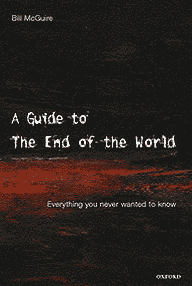 This little book tells us in plain and simple terms just how unlikely it is that we can expect to survive the whims of an unruly universe unscathed.
This little book tells us in plain and simple terms just how unlikely it is that we can expect to survive the whims of an unruly universe unscathed.
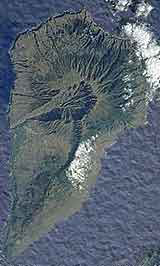
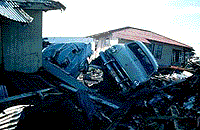 The incidence of death related to such events is often greater in poorer countries, where adequate flood defenses cannot be afforded, and where the infrastructure cannot avert disease in the wake of the disaster. Hence, the third world disasters find themselves referred to in the media in terms only of deaths, while western disasters are referred to in terms of cash costs as well. The threat from storms increases as population increases, in so far as people find themselves living in marginal territories, such as flood plains, through population pressures in a region.
The incidence of death related to such events is often greater in poorer countries, where adequate flood defenses cannot be afforded, and where the infrastructure cannot avert disease in the wake of the disaster. Hence, the third world disasters find themselves referred to in the media in terms only of deaths, while western disasters are referred to in terms of cash costs as well. The threat from storms increases as population increases, in so far as people find themselves living in marginal territories, such as flood plains, through population pressures in a region.
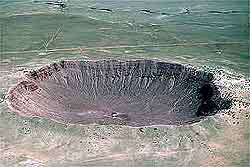 And, if we do not do for ourselves, the cosmos may give humankind a helping hand to shuffle off:
And, if we do not do for ourselves, the cosmos may give humankind a helping hand to shuffle off:
